 |
||
|
||
| ||
Although some say that the extensive development of the PC industry and, in particular, of personal computers has no prospects, this kind of development is not going to give up. There are no new memory types around the corner, but there is DDR memory overclocked to 166(333) MHz. AGP 4x is more than enough for video cards, but the 8x is already making its way onto the PC market. New promising buses are now developing but it's only nVidia that uses the HyperTransport in its highly progressive chipset; the rest use old types, and all those V-Link (of VIA) and MuTIOL (of SiS) easily expand/reduce bit capacity and bandwidth to adjust the current necessity. Theoretically, modern hard drives are able to transfer data at 133 MBytes/s, however, it doesn't help them to speed up to such values in a real life. The USB 2.0 is 40 times faster than its predecessor, but it's the only its difference, and so useful USB On-The-Go is still in the background. But it's not that bad. For example, every user of flash cards will feel very well acceleration of the USB 2.0. The new UltraATA133 protocol doesn't give a lot for a user, but it comes hand to hand with another Maxtor's innovation - "BigDrive" which removes restriction of 137 MBytes on a hard drive size. So when we say "FastDrive" (UltraATA133) we mean "BigDrive". The above technologies should be considered the most desirable for new chipsets, and today we are going to take a look at the one which corresponds to this recommendation. VIA KT333 chipset
 The architecture of the new chipset doesn't differ from its predecessor - VIA KT266A: two bridges linked with a high-speed bus and an LPC Super I/O chip which controls operation with a floppy drive, COM-, LPT-ports etc.
 The north bridge (VT8367) works with AMD Athlon, Athlon XP and Duron processors at 200/266 Mhz of the bus. The memory controller supports up to 4 GBytes of DDR200/266/333 SDRAM, thus allowing for 2.7 GBytes/s of the memory bandwidth in case of the DDR333. The ECC is supported, but it's unclear which memory modules should be used to get 4 GBytes. The memory controller is based on that of the KT266A. And the AGP bus controller still supports AGP interfaces up to 4x., though AGP 8x is not finished yet. VIA and Advanced Validation Labs developed a special program which checks whether memory modules comply to the "DDR333" standard. As you know, VIA chipsets, in particular P4X266, had some problems with DDR support. Now VIA makes every attempt to change the situation; it even states that modules and devices produced before February 2002 can't be considered as fully complying with the DDR333 specification.
 The VT8233A V-Link Client South Bridge has just only one new thing (which we spoke about earlier). Here are its brief characteristics:
The bridges are connected with the V-Link bus which operates at 66 MHz quad-pumped. The overall throughput is 266 MBytes/s. Let's take a gander at the prospects. The AGP 8x is coming soon, and VIA will soon release a new version of the KT333 - KT333A with support of this technology. All modern VIA bridges correspond to the concept of V-MAP (Modular Architecture Platform), and thus they can be interchanged without altering the layout. It makes possible to do illogical things like coupling the KT333 with aging south bridges, and also it makes possible to do quite useful things like usage of the VIA prepared VT8235 (probably for the announce of the KT333A) . This chip supports USB 2.0, and it means that external controllers are not necessary anymore. It's planned to expand the V-Link's bandwidth up to 533 MBytes/s by the release of the KT333A which will be helpful if several USB 2.0 devices are used. But mobo makers are not forced to wait, and there are already several announces of products based on the KT333+VT8235. As this article is the first dealing with Athlon XP 2000+ we are showing you its photo and its insides:

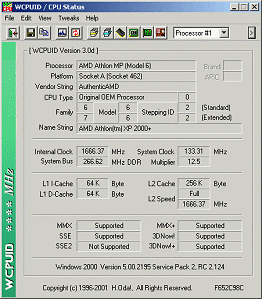 This ordinary model is based on the 0.18-micron process; and it lacks for any architectural innovations. The only that attracts attention is the figure 2000. The results will be published in the near future. Performance testTestbed:
Software:
I think it makes no sense to describe the reference board from VIA as it's not extraordinary and will hardly appear on the shelves. Here's its photo:
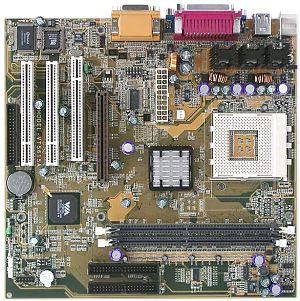 Test results

 There is no difference between the chipsets in MP3 coding: the speed is limited either by the disc subsystem or by the processor performance, that is why the faster memory doesn't allows for a considerable gain. In case of the WinZip archiving there is some gap, and although the KT333 is faster by 3% than its predecessor the leader is the SiS chipset; it means that the IDE controller of the SiS 735 is faster or the measurements are inaccurate.

 In these more memory-intensive cases the KT333 outscores the models best up to this moment by 3-4% in the first case and outdoes the others by 11% in the second one.

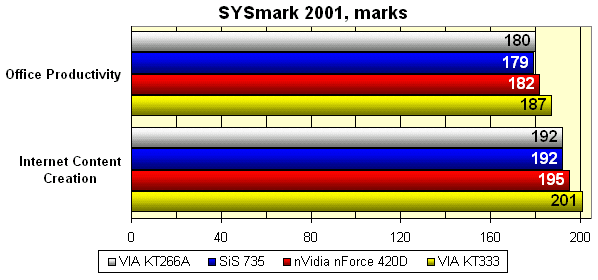 If we exclude the Business Winstone results, the situation will be expected: 3–4% advantage of the new chipset. Higher results shouldn't be expected as the tests are much connected with the performance of the disc subsystem. By the way, the leadership of the SiS735 in the Business Winstone may indicate that it operates better with the hard drive. It is interesting that the VIA's promotional materials show that the results of its chipsets in the SYSmark 2001 ICC correlate as 196/201.
 It's difficult to say whether these 5-10 seconds are a real or just imaginary advantage in the scene rendering speed, but anyway it's less than 2%.
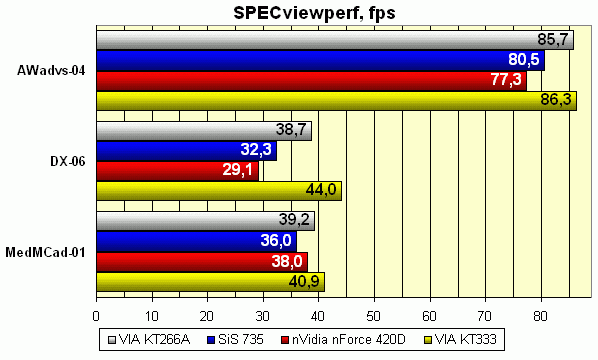 In the OpenGL tests of the SPECviewperf packet the VIA had the best results, and now they are improved by 14% in the DX-06 which is the most sensitive for a memory bandwidth. In the other tests the breakaway is smaller, but not less than 4–5% apart from AWadvs-04 where the results depend on the video card texturing speed and which clearly shows a weak point of the current SiS and NVIDIA chipsets - the AGP's speed or flaws in the GART driver: they fall behind by 7 - 50%(!!!).


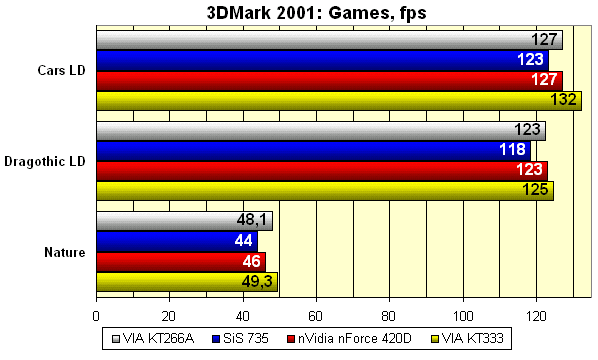

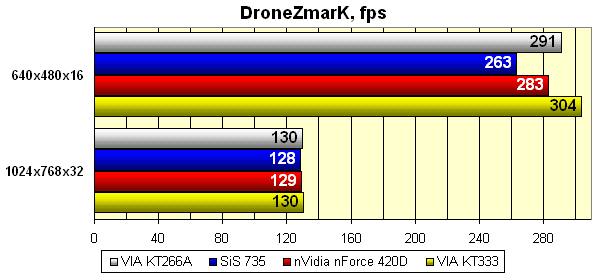 The slower memory of the SiS 735 is redoubled by a bad operation of the AGP, that is why it isn't able to beat the new VIA's chipset in games - the gap reaches 15% depending on resolution and resource dependence. The nForce looks more promising in games, but it still worse even than the KT266A. The latter fights desperately, but anyway, the KT333 outscores it by 5–6% in each test game. ConclusionThe new chipset from VIA suits excellently fast mainboards on the AMD processors. It does use the advantage in speed of the DDR333, and the breakaway is 5% on average: it varies from 0 to 10–15% depending on a test type in comparison with the VIA KT266A. Apart from the speed, the new chipset has some other highs. Its standard south bridge supports Maxtor "FastDrive"&"BigDrive", and if you look carefully you will find boards with the advanced south bridge VT8235, and you will, thus, get the USB 2.0 without any additional controllers. The rumor has it that the KT333 won't be used widely,
and boards will be produced yet on the KT333A. We shall see what
we shall see, and now I can state that the VIA KT333 becomes a champion
in speed among Socket 462 chipsets.
Write a comment below. No registration needed!
|
Platform · Video · Multimedia · Mobile · Other || About us & Privacy policy · Twitter · Facebook Copyright © Byrds Research & Publishing, Ltd., 1997–2011. All rights reserved. | |||||||||||||||||||||||||||||||||||||||||||||||||||||||||||||||||||||||||||||||||||||||||||||||||||||||||